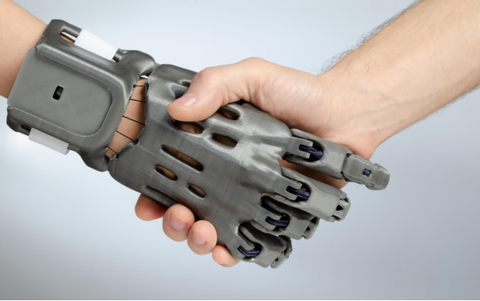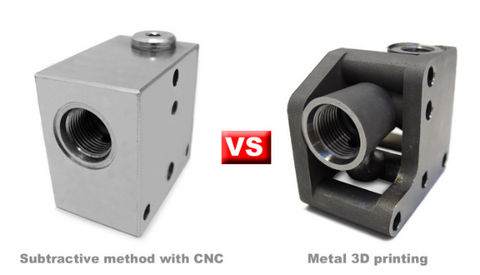In den letzten Jahren hat die Fertigungsindustrie mit dem Aufkommen der 3D-Drucktechnologie eine Revolution erlebt. Insbesondere der 3D-Druck von Metall hat sich als innovative und vielversprechende Technik herausgestellt, die die Zukunft der Fertigung neu gestalten wird.
Lassen Sie uns die Fortschritte im 3D-Druck von Metall, auch bekannt als additive Metallfertigung, untersuchen und ihre Auswirkungen auf den Industriesektor diskutieren. Von den Vorteilen und Anwendungen bis hin zum Potenzial, das es für die Fertigungsrevolution birgt, werden wir in die spannende Welt des 3D-Drucks von Metall und seine Rolle in der Zukunft der Fertigung eintauchen.
Der Aufstieg des 3D-Drucks in der Fertigungsindustrie
Da die Nachfrage nach Individualisierung und Effizienz in der Fertigung weiter steigt, hat sich der 3D-Druck als transformierende Technologie in der Branche herausgestellt. Die Möglichkeit, Metallobjekte Schicht für Schicht mithilfe von CAD-Modellen (Computer-Aided Design) zu drucken, hat Herstellern eine Welt voller Möglichkeiten eröffnet.

Einer der Hauptvorteile des 3D-Drucks von Metall ist die Reduzierung von Materialabfällen. Bei herkömmlichen Herstellungsverfahren wird häufig überschüssiges Material weggeworfen, was zu Ineffizienzen und höheren Kosten führt. Beim 3D-Druck von Metall wird nur die erforderliche Menge Metall verwendet, wodurch der Abfall minimiert und die Kosteneffizienz erhöht wird.
Darüber hinaus ermöglicht der 3D-Druck von Metall komplexe und komplizierte Designs, die mit herkömmlichen Fertigungsmethoden bisher nicht möglich waren. Diese Gestaltungsfreiheit ermöglicht es Herstellern, hochgradig individuelle und optimierte Metallprodukte herzustellen, wodurch Funktionalität und Leistung verbessert werden.
Fortschritte im 3D-Druck von Metall
Der Bereich des 3D-Drucks von Metall entwickelt sich ständig weiter. Es werden neue Fortschritte erzielt, um die Fähigkeiten und Anwendungen dieser revolutionären Technologie weiter zu verbessern. Forscher und Ingenieure verschieben die Grenzen des Möglichen und eröffnen Herstellern eine Welt voller Möglichkeiten.

Ein Bereich, in dem Fortschritte erzielt werden, ist die Entwicklung neuer Materialien für den 3D-Druck von Metall. Neben den traditionellen Metallen wie Stahl und Aluminium arbeiten Forscher daran, die Palette der druckbaren Materialien um Legierungen und sogar Edelmetalle zu erweitern. Dies eröffnet neue Möglichkeiten für Branchen wie die Luft- und Raumfahrt und die Schmuckindustrie, in denen Hochleistungs- und Spezialmetalle benötigt werden.

Ein weiterer Schwerpunkt ist die Verbesserung der Geschwindigkeit des 3D-Drucks von Metall. Obwohl die Technologie in Bezug auf die Effizienz große Fortschritte gemacht hat, besteht immer noch Verbesserungsbedarf. Forscher arbeiten an der Entwicklung schnellerer Druckprozesse und der Optimierung des Design- und Fertigungsablaufs, um die Produktionszeit zu verkürzen.
Darüber hinaus erleichtern Fortschritte bei Software und Designtools den Herstellern die Erstellung komplexer und komplizierter Designs für den 3D-Druck von Metall. Die Integration künstlicher Intelligenz und maschineller Lernalgorithmen ermöglicht es Designern, ihre Designs hinsichtlich Leistung und Effizienz zu optimieren, was zu hochfunktionalen und maßgeschneiderten Produkten führt.
Vorteile und Einschränkungen beim 3D-Druck von Metall
Einer der Hauptvorteile des 3D-Drucks von Metall ist die Möglichkeit, komplexe und komplizierte Designs zu erstellen, deren Herstellung bisher unmöglich oder sehr teuer war. Herkömmliche Fertigungsmethoden erfordern oft mehrere Schritte, Werkzeuge und Montage, aber beim 3D-Druck von Metall kann ein einzelnes, voll funktionsfähiges Teil in einem Durchgang hergestellt werden, wodurch der Montageaufwand reduziert und Materialabfall minimiert wird.

Darüber hinaus bietet der 3D-Druck von Metall Gestaltungsfreiheit, sodass Hersteller hochgradig individuelle Produkte herstellen können, die auf spezifische Anforderungen zugeschnitten sind. Diese Flexibilität ermöglicht die Herstellung einzigartiger, einmaliger Komponenten, seien es patientenspezifische medizinische Implantate oder maßgeschneiderte Autoteile, ohne dass teure Formen oder Werkzeuge erforderlich sind.

Wie jede Technologie hat jedoch auch der 3D-Druck von Metall seine Grenzen. Eine der größten Einschränkungen ist die Größe des Druckers selbst. Derzeit sind die meisten 3D-Drucker für Metall in ihrer Größe begrenzt, was die Größe der druckbaren Teile einschränkt. Eine weitere Einschränkung sind die hohen Kosten der für den 3D-Druck von Metall erforderlichen Geräte und Materialien, was ihn für kleinere Hersteller weniger attraktiv macht.
Darüber hinaus kann der Druckvorgang zeitaufwändig sein, insbesondere bei größeren und komplexeren Teilen. Obwohl ständig Fortschritte bei der Verbesserung der Druckgeschwindigkeit erzielt werden, ist dies ein Bereich, in dem noch weitere Entwicklungen erforderlich sind.
Branchen, die 3D-Druck für Metall einsetzen
Angesichts der zahlreichen Vorteile und Fortschritte überrascht es nicht, dass der 3D-Druck von Metall in allen Branchen auf dem Vormarsch ist. Eine Vielzahl von Branchen nutzt diese Technologie, um ihre Produktionskapazitäten zu verbessern und sich einen Wettbewerbsvorteil zu verschaffen.

Eine Branche, die stark vom 3D-Druck von Metall profitiert hat, ist das Gesundheitswesen. Mediziner können nun patientenspezifische Implantate und Prothesen herstellen und so die Präzision und Wirksamkeit der Behandlung verbessern. Diese Technologie ermöglicht auch die Herstellung komplexer medizinischer Geräte wie chirurgischer Instrumente und Zahnimplantate, die ein hohes Maß an Anpassung erfordern.
Auch die Automobilindustrie setzt auf den 3D-Druck von Metall. Hersteller können Leichtbauteile herstellen, die kraftstoffsparende Fahrzeuge ohne Kompromisse bei Festigkeit und Sicherheit ermöglichen. Darüber hinaus ist die Anpassung von Autoteilen an spezifische Designs und Anforderungen jetzt einfacher möglich, was mehr Innovation und Personalisierung ermöglicht.

Auch die Luft- und Raumfahrtindustrie macht große Fortschritte beim 3D-Druck von Metall. Mithilfe dieser Technologie können Hersteller komplexe und leichte Flugzeugkomponenten herstellen, die die Gesamtleistung verbessern und gleichzeitig den Treibstoffverbrauch senken. Die Fähigkeit, komplizierte Designs zu erstellen, die zuvor nicht realisierbar waren, hat die Zukunft der Luft- und Raumfahrttechnik geprägt.
Die Zukunft der Fertigung mit 3D-Druck aus Metall
Angesichts der zunehmenden Verbreitung und Weiterentwicklung des 3D-Drucks von Metall sieht die Zukunft der Fertigung unglaublich vielversprechend aus. Diese transformative Technologie wird den gesamten Produktionsprozess in verschiedenen Branchen revolutionieren. Während wir die Möglichkeiten dieser Technologie weiter erforschen und die Grenzen erweitern, können wir mit erheblichen Veränderungen in der Art und Weise rechnen, wie wir Waren herstellen.

Einer der wichtigsten Bereiche, in denen der 3D-Druck von Metall voraussichtlich große Auswirkungen haben wird, ist das Lieferkettenmanagement. Die traditionelle Fertigung erfordert oft komplexe und langwierige Lieferketten mit mehreren Lieferanten und Transportlogistik. Mit dem 3D-Druck von Metall können Hersteller Komponenten auf Anfrage produzieren, wodurch umfangreiche Lieferketten überflüssig werden und die Vorlaufzeiten verkürzt werden. Dies spart nicht nur Zeit und Geld, sondern ermöglicht auch mehr Flexibilität und Agilität bei der Reaktion auf die Marktnachfrage.
Darüber hinaus können wir mit der Weiterentwicklung der Technologie Fortschritte bei den für den 3D-Druck von Metall verwendeten Materialien erwarten. Derzeit gibt es verschiedene Metalllegierungen, die im 3D-Druckverfahren hergestellt werden können, jede mit ihren eigenen einzigartigen Eigenschaften und Anwendungen. In Zukunft werden wir möglicherweise die Entwicklung neuer Materialien erleben, die speziell für den 3D-Druck entwickelt wurden und eine verbesserte Festigkeit, Haltbarkeit und Hitzebeständigkeit aufweisen. Dies wird neue Möglichkeiten für die Herstellung von Hochleistungskomponenten eröffnen, die bisher nicht realisierbar waren.

Ein weiterer Bereich, auf den man achten sollte, ist die Integration von künstlicher Intelligenz (KI) und maschinellem Lernen in die 3D-Drucktechnologie für Metall. KI-Algorithmen können komplexe Designs analysieren und den Druckprozess optimieren, wodurch Fehler minimiert und die Effizienz verbessert werden. Darüber hinaus kann maschinelles Lernen dabei helfen, Muster und Trends in den Produktionsdaten zu erkennen, was eine kontinuierliche Verbesserung und Optimierung des Druckprozesses ermöglicht. Dies führt zu qualitativ hochwertigeren Produkten, weniger Abfall und schnelleren Produktionszeiten.
Das Potenzial des 3D-Drucks von Metall in der Fertigung nutzen
Zusammenfassend lässt sich sagen, dass das Potenzial des 3D-Drucks von Metall in der Fertigung nicht zu übersehen ist. Wie wir gesehen haben, hat diese transformative Technologie bereits erhebliche Auswirkungen auf die Branche, und die Zukunft sieht noch vielversprechender aus. Die Möglichkeit, Komponenten auf Anfrage herzustellen, kürzere Vorlaufzeiten und eine höhere Flexibilität bei der Reaktion auf Marktanforderungen sind nur einige der Vorteile, die der 3D-Druck von Metall mit sich bringt.
Zweifellos sieht die Zukunft der Fertigung mit 3D-Druckmetall rosig aus. Da immer mehr Branchen das enorme Potenzial erkennen und die Grenzen des Möglichen weiter verschieben, können wir eine Revolution in der Art und Weise erwarten, wie wir Waren produzieren. Es stehen spannende Zeiten bevor, und diejenigen, die diese transformative Technologie nutzen, werden für den zukünftigen Erfolg gut aufgestellt sein.
FAQ
1. F: Welche Vorteile bietet der 3D-Druck von Metall im Vergleich zu herkömmlichen Herstellungsverfahren?
A: Der 3D-Druck von Metall bietet Vorteile wie weniger Materialabfall, die Möglichkeit, komplexe Designs zu erstellen und eine höhere Kosteneffizienz, da nur die erforderliche Metallmenge verwendet wird. Dadurch werden Ineffizienzen beseitigt, die mit der herkömmlichen Fertigung verbunden sind.
2. F: Wie entwickelt sich der Bereich des 3D-Drucks von Metall und worauf konzentrieren sich Forscher und Ingenieure derzeit?
A: Forscher und Ingenieure arbeiten aktiv an der Entwicklung neuer Materialien für den 3D-Druck von Metallen. Dabei werden nicht nur traditionelle Metalle, sondern auch Legierungen und Edelmetalle verwendet. Darüber hinaus liegt der Fokus auf der Verbesserung der Druckgeschwindigkeit, der Optimierung von Designtools und der Integration künstlicher Intelligenz, um die Möglichkeiten und Einsatzmöglichkeiten dieser bahnbrechenden Technologie zu verbessern.
3. F: Was sind die Einschränkungen beim 3D-Druck von Metall und gibt es laufende Bemühungen, diese Herausforderungen zu überwinden?
A: Zu den Einschränkungen beim 3D-Druck von Metall zählen die Größenbeschränkungen der Drucker, hohe Geräte- und Materialkosten sowie zeitaufwändige Druckprozesse, insbesondere bei größeren und komplexeren Teilen. Laufende Forschungs- und Entwicklungsanstrengungen zielen darauf ab, diese Herausforderungen zu bewältigen, wobei der Schwerpunkt auf der Verbesserung der Druckgeschwindigkeit, der Kostensenkung und der Erweiterung der Palette der druckbaren Materialien liegt.
4. F: In welchen Branchen wird der 3D-Druck von Metall in bedeutendem Umfang eingesetzt und welche Vorteile bietet er diesen Sektoren?
A: Branchen wie das Gesundheitswesen, die Automobilindustrie und die Luft- und Raumfahrtindustrie setzen aktiv auf den 3D-Druck von Metall. Im Gesundheitswesen wird die Technologie für patientenspezifische Implantate und Prothesen eingesetzt, während sie in der Automobilindustrie die Herstellung von Leichtbauteilen für kraftstoffsparende Fahrzeuge ermöglicht. In der Luft- und Raumfahrt revolutioniert der 3D-Druck von Metall die Produktion komplexer und leichter Flugzeugkomponenten und verbessert die Gesamtleistung und Kraftstoffeffizienz.

